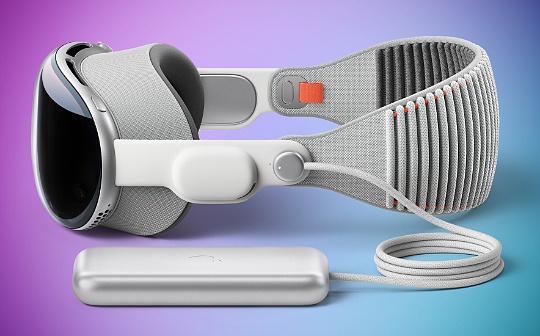
Just one month ago, this “epoch -making” MR head was displayed in pre -sale in North America. On February 2 this year, the world’s first batch of players in the world began to receive the goods. According to the official purchase policy of a fruit, it received on February 2nd.Players who arrived in the goods had a total of 14 days of experience, that is, it can be returned unconditionally before February 16.Sure enough, just two days ago, the news of “Vision Pro suffered a large number of returns” blossomed in the major media on the major media. The biggest slot was Vision Pro, which would have discomfort, and related applications were incomplete.In fact, recent media news pointed out that the Vision Pro headset pre -installed application is pre -installed 50%unfinished optimization. Snazzy Labs quoted people familiar with the matter that in the Vision Pro pre -installed application, only about half of the applications have been optimized around Vision Pro.Even several applications are just running as window -based iPados applications.
Of course, market investors are currently cautious about Vision PRO. In addition to the bulky and incomplete applications such as wearing the above mentioned above, there may be a more serious problem, that is, a more serious problem, that is, that is, that is,In fact, Vision PRO’s compliance in other countries, in fact, Vision Pro is likely to have privacy issues such as infringing on personal information of citizens.
01Privacy risks from external
In addition to the privacy risks from external attackers, Vision Pro also has media sharing risk from players. For example, when we meet a passenger holding a mobile phone on the opposite side, we will naturally feel uncomfortable and worry about passengers.Whether to use your mobile phone to take pictures to invade privacy.And MR devices such as VISION PRO have more cameras, and the image capture is more secretive. Imagine such a scene. When we take the subway, we encounter a passenger wearing a Vision Pro helmet.Take pictures with Vision Pro without knowing it.Of course, a fruit company has considered the corresponding solution when designing the Vision Pro product design.certainThe strategy given by the fruit company is that when taking photos or videos of Vision Pro, the device screen will light up the indicator light, so that the surrounding people know that Vision Pro players are taking space photos or videos to indicate the corresponding privacy riskEssenceHowever, whether this strategy can play a role in privacy protection, it is still doubtful. In fact, the problem of screen prompts during shooting through “jailbreak” or similar means is not too difficult to technically.And with the development of XR -type equipment, this problem is not only a problem that the Vision Pro needs to face, but other MR manufacturers also need to solve the privacy risks brought by media sharing.
02Personal information protection compliance risk from internal
In addition to the above -mentioned attackers from Vision PRO and the privacy risks brought by user media sharing, the Vision Pro MR device also faces the risk of compliance with personal information collection in my country.Sister Sister’s team early in the article “>MR head display: Vision Pro, “legal risk Pro” in the virtual reality industry?“It has been showed that some VR helmets are currently collecting and scanned the user’s facial contour, iris, retinal and other biological information.Litigation cases about VR equipment collection sensitive information have appeared abroad.According to my country’s “Personal Information Protection Law”, related biological information may be sensitive personal information, which has touched the risk of collecting sensitive information. Practitioners must pay attention to the compliance settings of related issues.
In fact, information such as iris, facial recognition characteristics, eye movement time and other information has high commercial value, which is likely to cause compliance risks. Taking eye movement time as an example, when the device collects user eye movement time data, the device collects the user’s eye movement time data, andYou can analyze the concentration of users ‘attention under specific environments. This method can be widely used in personalized advertising. For example, MR devices can collect users’ eye movement time, analyze user eye movements for the longest time for the longest time,The content that MR is playing, and further puts similar advertisements based on these contents, thereby increasing the customer acquisition rate.Such information with commercial value is likely to cause disclosure of user privacy risks.Except for the problem of eye movement, a certain fruit is based on Vision Pro. The Optic ID developed based on iris recognition system can directly analyze the user’s iris information in various non -visible LED light, and then determine the user’s identity.Although the official website of a fruit stated that the iris information is completely encrypted, it is difficult for users to master whether the information is true. At the same time, the risk of compliance risks of the device that collects iris information itself is also very large.
03At the end
In addition to the above -mentioned privacy risks, in fact, the MR system is also facing a number of compliance content such as content governance compliance and intellectual property anti -fraud compliance. my country’s “Network Information Content Ecological Governance Regulations” requires the network information content service platform to fulfill the information content of the information content Management subject responsibility, strengthening information content management of this platform, XR -class equipment, application developers and operators should pay attention to fulfilling the content governance obligations in the above provisions to achieve compliance with content governance.
At the same time, XR equipment and application developers also face important intellectual property protection issues. Should buildings in digital twin cities be protected by copyright under virtual reality technologies such as digital twin?Does it constitute a corresponding infringement to a certain object with copyright protection?This requires practitioners to demonstrate in detail to avoid infringement risks.The obligation of anti -fraud and anti -misleading is also another major legal risk faced by the virtual reality industry. In recent years, virtual reality and artificial intelligence, especially AIGC technology, are integrated. AIGC technology is likely to produce a lot of “false” information.The empowerment of virtual reality technology will generate huge destructive power. Related practitioners must pay attention to such legal risks, do a good job of anti -fraud and anti -misleading obligations, and enhance their own compliance.
While the “space computing era” opened by Vision Pro, while opening a new round of smart software and hardware reform, it will also bring privacy risks, content risks, and intellectual property risks.The problem is also a compliance problem in the entire XR market, and each compliance point should be treated with caution.








